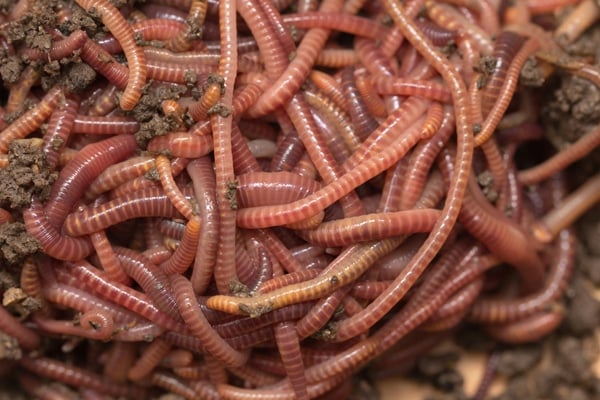Red Wigglers: The Unsung Heroes of Organic Waste Recycling
Red wigglers, or Eisenia fetida, serve as important agents in the organic waste recycling procedure, changing disposed of products right into valuable vermicompost. Their efficient break down of natural issue not just improves soil quality however likewise adds to lasting waste administration techniques. As the globe significantly looks for options to combat waste buildup and boost agricultural efficiency, understanding the duty of these worms becomes vital. What mechanisms enable them to thrive in compost atmospheres, and exactly how can they be effectively made use of in both household and business setups? Checking out these questions exposes the more comprehensive implications of vermicomposting in our ecological landscape.
What Are Red Wigglers?
The remarkable resilience of red wigglers, clinically called Eisenia fetida, underscores their important duty in organic waste recycling. These tiny, reddish-brown earthworms are normally located in disintegrating organic issue, such as garden compost heaps and manure lots. Lake Hickory Bait. Unlike other earthworm varieties, red wigglers flourish in nutrient-rich atmospheres and are very effective at breaking down organic products, making them necessary for vermicomposting

(Red Wiggler Express)In addition to their function in waste decrease, red wigglers add to dirt health and wellness by enhancing dirt structure and aeration via their tunneling activities (Lake Hickory Bait). Their visibility in composting systems not only improves decay rates but also promotes a lasting approach to lose administration, illustrating their significance in environmental conservation efforts
Benefits of Composting With Worms
Composting with worms, specifically red wigglers, offers many advantages that enhance both waste management and soil health and wellness. Initially, these worms efficiently damage down natural waste, transforming it into nutrient-rich vermicompost that enhances dirt. This process increases disintegration, enabling a much faster recycling of kitchen area scraps and various other organic products contrasted to conventional composting methods.
In addition, the vermicompost produced by red wigglers is bristling with advantageous microorganisms, which assist enhance dirt framework, aeration, and dampness retention. This enhances the overall wellness of plants, promoting energetic development and enhanced returns in yards and farming settings. The usage of worms in composting reduces the manufacturing of greenhouse gases, such as methane, adding to a more sustainable waste management system.

How to Beginning Vermicomposting
Developing a vermicomposting system is a straightforward procedure that can yield considerable advantages for both waste administration and soil enrichment. To start, select a suitable container, such as a plastic container or wooden box, with appropriate air flow openings to make certain correct air movement. The dimensions ought to preferably be around 2 feet by 3 feet, allowing adequate room for the worms to grow.
Next, prepare bedding material, which can contain shredded paper, cardboard, or coconut coir. This bed linen should be dampened to produce a suitable environment for the worms. As soon as the bedding remains in place, introduce red wigglers (Eisenia fetida) right into the container, normally around one pound of worms for each square foot of surface location.
Complying with the placement of worms, include organic waste, such as fruit and veggie scraps, coffee premises, and crushed eggshells. With these actions, you will properly launch a vermicomposting system that adds to sustainable waste monitoring and enhances your soil.
Maintaining a Healthy Worm Container
(Red Wiggler Express)Keeping a worm bin prospering calls for normal focus and like guarantee the health of the red wigglers and the performance of the composting procedure. Proper maintenance begins with checking the dampness levels; the container should perspire yet not soaked. A great general rule is to preserve a consistency comparable to a wrung-out sponge.
Carefully mixing the bed linen and food scraps every few weeks protects against compaction and ensures that all worms have access to oxygen. Additionally, it is vital to feed the worms properly.
Temperature level law is one more vital facet. Red wigglers flourish in a series of 55 to 77 levels Fahrenheit. If the container ends up being too hot or chilly, the worms might end up being worried - Lake Hickory Bait. Lastly, periodically look for indications of wellness, such as worm population development and the presence of healthy spreadings. By carefully handling these factors, one can maintain a durable and productive worm container.
Impact on Sustainable Living
The effective upkeep of a worm bin not only profits the wellness of red wigglers however additionally contributes dramatically to lasting living techniques. By recycling organic waste, such as kitchen scraps and backyard debris, red wigglers help divert significant amounts of material from landfills. This decrease in waste not just lowers greenhouse gas emissions but likewise reduces the ecological problem connected with waste management.
Additionally, the spreadings created by red wigglers act as a nutrient-rich organic fertilizer, improving soil health and promoting Extra resources plant development. This all-natural choice to chemical plant foods sustains lasting farming and gardening practices, minimizing reliance on synthetic inputs that can harm communities. In addition, worm composting cultivates awareness of waste administration, motivating people and communities to adopt more sustainable behaviors.

Final Thought
In summary, red wigglers serve as essential contributors to natural waste recycling through their efficient decay of organic materials. By integrating vermicomposting into waste administration methods, people and areas can dramatically minimize waste while advertising environmental sustainability.